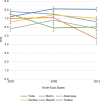Contraceptive use and distribution of high-risk births in Nigeria: a sub-national analysis
- PMID: 26562145
- PMCID: PMC4642363
- DOI: 10.3402/gha.v8.29745
Contraceptive use and distribution of high-risk births in Nigeria: a sub-national analysis
Abstract
Background: Family planning expansion has been identified as an impetus to harnessing Nigeria's demographic dividend. However, there is a need for data to address pockets of inequality and to better understand cultural and social factors affecting contraceptive use and health benefits. This paper contributes to addressing these needs by providing evidence on the trends and sub-national patterns of modern contraceptive prevalence in Nigeria and the association between contraceptive use and high-risk births in Nigeria.
Design: The study utilised women's data from the last three Demographic and Health Surveys (2003, 2008, and 2013) in Nigeria. The analysis involved descriptive, bivariate, and multivariate analyses. The multivariate analyses were performed to examine the relationship between high-risk births and contraceptive use. Associations were examined using Poisson regression.
Results: Findings showed that respondents in avoidable high-risk birth categories were less likely to use contraceptives compared to those at no risk [rate ratio 0.82, confidence interval: 0.76-0.89, p<0.001]. Education and wealth index consistently predicted significant differences in contraceptive use across the models.
Conclusions: The results of this study suggest that women in the high-risk birth categories were significantly less likely to use a modern method of contraception relative to those categorised as having no risk. However, there are huge sub-national variations at regional and state levels in contraceptive prevalence and subsequent high-risk births. These results further strengthen evidence-based justification for increased investments in family planning programmes at the state and regional levels, particularly regions and states with high unmet needs for family planning.
Keywords: Nigeria; contraceptive use; estimates; high-risk births; sub-national.
Figures








Similar articles
-
Trends in contraceptive use and distribution of births with demographic risk factors in Ethiopia: a sub-national analysis.Glob Health Action. 2015 Nov 9;8:29720. doi: 10.3402/gha.v8.29720. eCollection 2015. Glob Health Action. 2015. PMID: 26562138 Free PMC article.
-
Trends and patterns of modern contraceptive use and relationships with high-risk births and child mortality in Burkina Faso.Glob Health Action. 2015 Nov 9;8:29736. doi: 10.3402/gha.v8.29736. eCollection 2015. Glob Health Action. 2015. PMID: 26562142 Free PMC article.
-
Gender norms and modern contraceptive use in urban Nigeria: a multilevel longitudinal study.BMC Womens Health. 2018 Oct 29;18(1):178. doi: 10.1186/s12905-018-0664-3. BMC Womens Health. 2018. PMID: 30373570 Free PMC article.
-
Impact of family planning programs in reducing high-risk births due to younger and older maternal age, short birth intervals, and high parity.Semin Perinatol. 2015 Aug;39(5):338-44. doi: 10.1053/j.semperi.2015.06.006. Epub 2015 Jul 10. Semin Perinatol. 2015. PMID: 26169538 Review.
-
A narrative review of evidence to support increased domestic resource mobilization for family planning in Nigeria.BMC Womens Health. 2023 May 6;23(1):235. doi: 10.1186/s12905-023-02396-y. BMC Womens Health. 2023. PMID: 37149568 Free PMC article. Review.
Cited by
-
Prevalence and determinants of unmet need for contraception among women in low and high-priority segments for family planning demand generation in Nigeria.Arch Public Health. 2022 Nov 21;80(1):239. doi: 10.1186/s13690-022-00997-x. Arch Public Health. 2022. PMID: 36404339 Free PMC article.
-
Women Deprivation Index and Family Planning Utilisation in Urban Geography of West African Countries.Front Glob Womens Health. 2021 Jun 16;2:656062. doi: 10.3389/fgwh.2021.656062. eCollection 2021. Front Glob Womens Health. 2021. PMID: 34816213 Free PMC article.
-
Trends, patterns and determinants of long-acting reversible methods of contraception among women in sub-Saharan Africa.PLoS One. 2019 Jun 4;14(6):e0217574. doi: 10.1371/journal.pone.0217574. eCollection 2019. PLoS One. 2019. PMID: 31163050 Free PMC article.
-
Persisting Regional Disparities in Modern Contraceptive Use and Unmet Need for Contraception among Nigerian Women.Biomed Res Int. 2019 Feb 18;2019:9103928. doi: 10.1155/2019/9103928. eCollection 2019. Biomed Res Int. 2019. PMID: 30906784 Free PMC article.
-
Inequality gaps in modern contraceptive use and associated factors among women of reproductive age in Nigeria between 2003 and 2018.BMC Womens Health. 2024 Jun 1;24(1):317. doi: 10.1186/s12905-024-03167-z. BMC Womens Health. 2024. PMID: 38824536 Free PMC article.
References
-
- United Nations. World population prospects: the 2012 revision. New York: Population Division of the Department of Economic and Social Affairs of the United Nations Secretariat; 2012.
-
- National Population Commission (NPC) [Nigeria] and ICF International. Nigeria demographic and health survey 2013. Abuja: NPC and ICF International; 2014.
-
- Family Planning and Reproductive Health Indicators Database. 2015. Available from: http://www.cpc.unc.edu/measure/prh/rh_indicators/specific/fp/cpr [cited 12 May 2015].
-
- National Population Commission (NPC) [Nigeria] and ICF Macro. Nigeria demographic and health survey 2008. Abuja: National Population Commission and ICF Macro; 2009.
-
- Akinyemi AI, Aransiola JO, Banjo O, Bamiwuye O, Fadeyibi O, Adewuyi A. Influence of independent and proximate variables on condom use in selected states in Nigeria. Afr J Reprod Health. 2010;14:53. - PubMed
Publication types
MeSH terms
Grants and funding
LinkOut - more resources
Full Text Sources
Other Literature Sources
Medical
